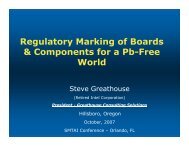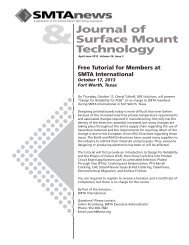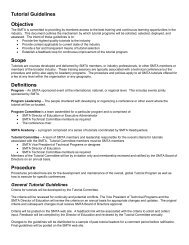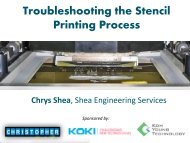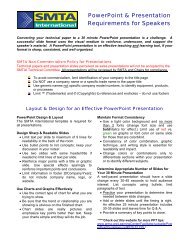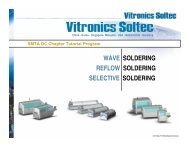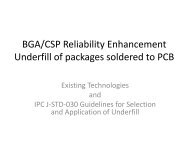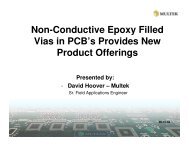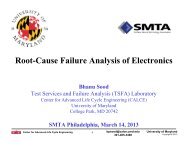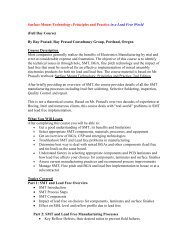a root cause failure mechanism for solder joint integrity - SMTA
a root cause failure mechanism for solder joint integrity - SMTA
a root cause failure mechanism for solder joint integrity - SMTA
Create successful ePaper yourself
Turn your PDF publications into a flip-book with our unique Google optimized e-Paper software.
25 micro inchesFigure 5 SEM cross-section of IG separation of EN nodules6. Small Section Black Band (figure 6)Small section black bands are a higher level of hyperactiveIG, in which spreading is continuous throughout severaladjoining nodules. Small section black band arbitrarilydefined as any continuous corrosion layer spreading that canentirely be viewed at 5000x magnification.200 micro inchesFigure 7 SEM cross-section of corner section black band.100 micro inchesFigure 8 SEM cross-section of large section black band10 micro inchesFigure 6 SEM cross-section of small section black bandFigure 9 shows a plane view micrograph of the black padsurface after <strong>solder</strong> <strong>joint</strong> <strong>failure</strong>. The black pad <strong>failure</strong>usually shows a clean separation at the trans<strong>for</strong>med Nisurface. Little to no Ni/Sn intermetallic is observed at the Nisurface or on the component lead. The back surface has asignature “mud cracked’ appearance and phosphorousconcentrations exceeding 10 wt. %.7. Corner Section Black Band (figure 7)Corner section black band is also a special case of a highlevel of continuous hyperactive IG. In this case thecontinuous corrosion band is confined to the corners oredges of pads. In the observation of the DOE there waseither a lot of corner section activity on the sample, or noneat all. In either case no strong correlation to chemicalparameters could be made.8. Large Section Black Band (figure 8)This is the highest level of IG hyperactivity. At this level thecorrosion consumes large areas of a pad. The corrosion bandthickness has been observed up to ¼ of the bulk Ni layer. IGspikes are also visible in this view and will be shown laterhow spike corrosion progresses to continuous black band.Thick IG is also observed above the black band region,which makes it extremely hard to detect at the platingprocess stage. This is a cross-sectional view of the marginalto non-wetting defect known in the assembly industries as“black pad”.50 micro inchesFigure 9 - Surface structure of the black pad defect.SEM cross-section sample preparation by mechanicalpolishing and etching can sometimes smear out the finestructure that you would like to observe. It is important to
understand fully how IG hyperactivity effects the Nisurface. It is the fine structure and surface composition thatshall dictate how well the bonding intermetallic shall <strong>for</strong>mbetween Ni and Sn. High magnification SEM views(30,000x to 80,000x) of black band defect suggest that thestructure may be voided or less dense then the underlyingdisturbed bulk Ni. The FIBM micrographs of figure 10a and10b give another view of the structure of the defect.Several long spikes can be observed in figure 10a. The longspike in the higher magnification view is at the boundarybetween two nodules and appears to be voided. Also,smaller voided spikes are observed to be running in thenodules between the boundaries. While ion beam millingdoes produce some damage and preferential etching, it isclear that the near surface is voided and less dense than thebulk of the Ni Layer.Number of Defects80706050403020100Sample 3Sample 6Sample 91 3 5 7 9 11 13 15 17 19 21Pad NumberFigure 11 Defect density vs. pad number <strong>for</strong> type 1defects.This was the first direct evidence that hyper IG corrosiondid not occur randomly. Some other unknown factors wereat work producing or triggering hyper IG corrosion. Padconnectivity was not taken into account <strong>for</strong> this DOE; norwas any attention given to IG plating distributions or localelectric field effects.50 micro inchesFigure 10a – FIBM image of a spike/spreader defect region.Following the chemical factor DOE, an assembly test wasper<strong>for</strong>med to evaluate <strong>solder</strong> <strong>joint</strong> <strong>integrity</strong> <strong>for</strong> new EN/IGprocess control midpoints and limits. The vehicle selected<strong>for</strong> the test was a double-sided board with a fine pitch QFPpattern. No electrical connectivity was given to any of theQFP pads. Hundreds of individual leads were tensile pulledand all ductile fractures of the <strong>solder</strong> were observed. Figure12 shows a typical view of an interface region. There was avery low density of defect types 1 to 4, but at the same timethere was a well-defined uni<strong>for</strong>m and continuous layer ofNi/Sn intermetallic.10 micro inchesFigure 10b – Selected higher magnification of a region in 10a.Identification of the microstructure <strong>for</strong> the defect activitywas a major step <strong>for</strong>ward in establishing <strong>root</strong> <strong>cause</strong>. Anotherimportant piece of in<strong>for</strong>mation that came out of thechemical DOE was the fact that the defect density was notdistributed randomly. Defect densities where determinedaccording to type <strong>for</strong> all 21 samples in the DOE run. Whilethere was only a weak correlation to defect type andexperimental factors, a pattern began to emerge with respectto defect density and QFP pad number. Figure 11 shows thedefect density vs. pad number <strong>for</strong> three sample of the type 1defect. The data shows that high defect activity tended to beclustered to a few pads.25 micro inchesFigure 12 – Normal interface structure <strong>for</strong> <strong>solder</strong> <strong>joint</strong>on double sided assemble test vehicle
VOLTAGE INDUCED IG HYPER ACTIVITYThe previous work yielded a lot of useful in<strong>for</strong>mation intothe nature of the black pad defect and hyperactivecharacteristics of the immersion gold process. While IGhyperactivity was found not to occur randomly, we still didnot know what or how to turn the effect on and off. The nextstep was deriving a model from the known facts and then toput the model to the test. The assumptions of the model are:Figure 14a and 14b show the microstructure of the blackpads. The induced black pads have all the samecharacteristics, (mud crack appearance, rough surface andhigh phosphorous concentration) as the naturally occurringblack pads. Figure 14b shows that the induced corrosionattack in some places was severe, nearly destroying thestructural <strong>integrity</strong> of whole nodules.1. IG hyper corrosion and black pad does not occurrandomly across the surface of a PCB but is localized.2. PCB design and construction may influence black bandactivity.3. Local electric field or charge density may trigger IGhyper corrosion and black pad.4. Corrosion of the Ni surface is due to activity in theimmersion gold process.In designing an experiment to test the model, an 8 layerPCB with multiple power and ground planes was selected.The PCB also had several areas with high pin, count finepitch SMT layouts. Lead wires were <strong>solder</strong>ed to large SMDcapacitor pads near one end of the circuit board. The end ofthe circuit board with the wire leads was kept outside of theplating solution. The circuit board was processed undernormal plating conditions up to the immersion gold platingtank. During immersion gold plating, the wire leads wereeither: (a) not connected, (b) shorted together or (c)connected to a constant voltage power supply.The (a) control boards had low defect densities types 1 to 4and no black pad defect was observed. The (b) controlboards seem to show a reduction in defect densities and onlytypes 1 and 2 were observed. Power and ground shorting bydesign is currently being investigated as means of inhibitinghyper corrosion activity [4]. No black pad defect wasobserved on the (b) control boards. Figure 13 shows theresults <strong>for</strong> +1 volt applied during the plating process. Thefour black pads in the right of figure 13 were connected to+1 volt and the orange color pads from the left to middle ofthe figure were connected to ground. Under this appliedvoltage condition all pads connected to +1 volt turned blackand all pads connected to ground turned orange.100 micro inchesFigure 14a – Voltage induced black pad <strong>for</strong>mation.5 micro inchesFigure 14b – Severe Ni nodule corrosion during inducedblack pad <strong>for</strong>mationThe orange pads turned out to be somewhat of a surprise.Highly accelerated gold plating occurred on all the padsconnected to ground. Large cubic gold crystals wereobserved throughout the orange pad surface as shown infigures 15a and 15b. The orange pad average grain size wasmore than 1000 times that of normal immersion gold grainsize. The orange color of these pads is due to the large grainsize and surface roughness.Figure 13 – Black pad induced corrosion at +1 voltapplied during IG plating.It should also be pointed out that the effect is highlylocalized. Figure 13 shows a single bright normal IG padbetween adjacent orange pads.
and at the same time no gold is being deposited during thedefect corrosion process.9000100 micro inchesFigure 15a – Orange pad connected to ground potentialgold platingIntensity800070006000500040003000200010000CNiBlack Band Spectrum P is9.8 wt.%Bulk Ni Spectrum P is 4.6wt.%P0 2000 4000 6000 8000 10000Energy (eV)NiNiFigure 16 – ESD spectra pre<strong>for</strong>med in a cross-sectionsample comparing bulk Ni to a black band defect region.10 micro inchesFigure 15b – Large cubic grain structure of the orangepads. The average grain size is more than 1000 timesthat of normal immersion goldPHOSPHORUS ENRICHMENT IG HYPERACTIVEINDUCED VS. NATURALThere has been a lot of activity in recent years concerningphosphorous concentrations in Ni, and <strong>solder</strong>ability [3,5].Several studies have made a distinction of a P enrichmentlayer but the <strong>mechanism</strong> <strong>for</strong> its <strong>for</strong>mation has not beenclearly defined. This section will show that there are twodistinct methods of P enrichment.The black band defect is a phosphorus-enriched layer<strong>for</strong>ming at the Ni / <strong>solder</strong> interface region with as much as2x the normal bulk P concentration of 4 to 7 wt.%. Figure16 shows a typical EDS spectra comparing P concentrationsin bulk Ni (4.6 wt.%) to black band P (9.8 wt.%). While ourEDS detector efficiency is low <strong>for</strong> C, N and O, no tracecontaminate could be detect above the background level.Volume enrichment of phosphorus by defect activity occursby the removal of Ni atoms into a depth of the near surface,100 micro inchesFigure 17a – Solder <strong>joint</strong> with black band defect10 micro inchesFigure 17b – Solder <strong>joint</strong> with black band defect shownin backscatter image modeFigure 17a and 17b show two examples of a phosphorousenrichment as a result of black band defect <strong>for</strong>mation. Inboth cases phosphorous enrichment is 9 to 12 wt.%. It
should be noted that these two examples also show thatthere is nearly a complete absence of Ni/Sn intermetallic.On the other hand, figure 18 shows an example of aninterface area <strong>for</strong> a good <strong>solder</strong> <strong>joint</strong>. No IG corrosion typedefects are observed in this view area. The Ni/Snintermetallic is visible just above a thin black band at the Nilayer interface. The thin black band is a phosphorousenriched zone that <strong>for</strong>ms as a result of near surface Nidepletion in the <strong>for</strong>mation of the intermetallic.patterns on a circuit board. It has also been used to show theevoultion of the hyper corrosion process and confirm resultsobtain in cross-section analysis.Figure 19a shows an area of Ni surface on an SMT pad aftercyanide stripping of the IG layer. The surface topography iswhat is to be expected after E Ni plating and no disturbanceis detected from the cyanide strip. Figure 19b shows a viewof the initial stage of the hyper corrosion attack. Thecorrosion attack is clearly initiated at the Ni noduleboundaries. Also, at this stage of attack Ni/Sn intermetallichas been observed to <strong>for</strong>m on smooth undisturbed domes ofthe Ni nodules. Relatively strong <strong>solder</strong> <strong>joint</strong> strength can beachieved at this stage of attack.100 micro inchesFigure 18 – Thin black layer of natural P enrichmentThe intermetallic <strong>for</strong>ms the bond between tin in the <strong>solder</strong>and the base metal nickel. The initial intermetallic <strong>for</strong>mationoccurs when molten <strong>solder</strong> comes into contact with the basemetal nickel. If the intermetallic is not allowed to <strong>for</strong>m,wetting of the surface does not occur. Also, if initialintermetallic <strong>for</strong>mation is retarded as in the case of figures17a and 17b, then the bond strength will be weak andinterfacial fracture occurs as has been reported in manycases. So the questions which should asked are: (a) doesnatural phosphorous enrichment pose a reliability issues(i.e., is the thin natural black band an areas <strong>for</strong> interfacialfracture), (b) does defect enriched phosphorousconcentration and the structural state of P-Ni play asignificant role in intermetallic <strong>for</strong>mation? These shall betopics <strong>for</strong> further research at HADCO Corporation.BLACK PAD SURFACE ANALYSIS BY CYANIDEETCHINGWhen the hyper corrosion activity strikes an area of a boarda thicker than normal IG layer will usually plate on top of it.This has made the defect extremely hard to detect andcharacterize. Also, cross-section microanalysis has beenvery useful in identifying and classifying the defect types tothis point but the areas examined in cross-section are verysmall in relation to an area of a printed circuit board. Ascreening test has been devised [6] in which cyanide is usedto strip off the IG layer and reveals a P-Ni surface that hasnot been corrupted by the stripping process. This screeningtest has been helpful in identifying hyper corrosion attack50 micro inchesFigure 19a – Normal Ni surface after cyanide strip25 micro inchesFigure 19b – First stage of corrosive attack is at the Ninodule boundariesThe next stage of attack is shown in figure 19c. Here we cansee that the attack has now proceeded well into the Ninodule. On closer examination it is observed that the attackis also confined to a defined thickness of the near Nisurface. At this stage of attack an intermetallic will still<strong>for</strong>m on top of the Ni domes but, be<strong>cause</strong> the mud crack like
surface area has increased, the <strong>solder</strong> <strong>joint</strong> strength willbegin to deteriorate. The final stage of hyper corrosionattack is shown in figure 19d. Here the smooth Ni domes arealmost entirely removed. The mud cracked signaturetopography of the black pad condition is undeniable. It isdifficult to get Ni/Sn intermetallic growth to this surfaceunder standard reflow conditions. In referring back to figure9 which shows the black pad condition found after <strong>solder</strong><strong>joint</strong> <strong>failure</strong>, the microstructure and high phosphorousconcentration found on the surface of figure 19 are thesame.CONCLUSIONSWe have structurally identified a <strong>root</strong> <strong>cause</strong> <strong>failure</strong><strong>mechanism</strong> <strong>for</strong> the electroless Ni / Immersion Au surfacefinish. The structural defect is commonly known as theblack pad condition. The black pad defect manifest itself asa marginal to total non-wetting surface to <strong>solder</strong>.It has been shown that the black pad defect is due to a hypercorrosive activity of the immersion gold process on the nearnickel surface. Eight levels of defect activity have beenidentified. The lower activity levels do not presence <strong>solder</strong><strong>joint</strong> reliability issues. The highest activity level, black pad,creates an enriched phosphorous layer called black band. Ithas been shown that black band phosphorous enrichment isdistinguishable from a thin layer of nature phosphorousenrichment created during Ni/Sn intermetallic <strong>for</strong>mation.We have shown that an applied voltage can induce IG hypercorrosion activity and that the defect activity is pad specific.Charge buildup near nodule boundaries triggers hypercorrosion. Long traces (with several ohms of resistance)with differential pad plating surface area may induce thecondition of charge buildup by the galvanic reaction. Workis currently in progress to identify significant chemicalfactor, which in the presence of charge buildup areresponsible <strong>for</strong> hyper corrosion activity.50 micro inchesFigure 19c – A more advanced stage of corrosive attackinto a define Ni layer50 micro inchesFigure 19d – Final stage of corrosive attack with themud cracked black pad appearanceThe micrographs shown in this section all came from threeadjacent SMT pads. We must also kept in mind that whilethis hyper corrosion process is taking place that a thickerthen normal layer of IG is also plating on top. The questionwe must now ask is, what set of chemical reactions (beyondthe normal IG galvanic reaction) in the presence chargebuildup is responsible <strong>for</strong> the corrosion effect?ACKNOWLEDGMENTThe author would like acknowledge Jennifer Burlingame ofHADCO Santa Clara Inc., Mike Toben and Eric Huenger ofShipley-Ronal Inc. <strong>for</strong> their assistance and running theDOE’s which made this work possible.REFERENCES1. K. Puttlitz, “Preparation, structure and fracture modesof Pb-Sn and Pb-In terminated flip-chip attached togold capped microsockets”, IEEE Trans-CHMT, vol.13 1990, pp. 647 – 655.2. E. Bradley and K. Banerji, “Effects of PCB finish onthe reliability and wettability of BGA packages”, ECTCconf proceedings, 1995, pp. 1028 – 1030.3. Z. Mei, P. Callery, D. Fisher, F. Hua, J. Glazer,“Interfacial fracture <strong>mechanism</strong> of BGA packages onelectroless Ni/Au”, EEP-Vol. 19-2, Advances inElectronic Packaging, 1997.4. N. Biunno and J. Burlingame, current work in progress,HADCO Santa Clara, Inc.5. M. McLean and G. O’Brien, “Effect of co-deposit ofphosphorus in nickel on <strong>solder</strong>ability as a function ofnickel bath age in the electroless nickel immersion goldprocess”, unpublished.6. M. Toben, LeaRonal, Inc., private communication.



